

- Best macosx local password vault for mac os x#
- Best macosx local password vault mac#
That’s important to note - FileVault will not encrypt a MacBook’s disk when the computer is asleep or on battery power.
Best macosx local password vault mac#
Once FileVault is enabled, it encrypts the startup disk as you use the Mac but only when the computer is awake and connected to AC power. This is important to remember! What Happens Once FileVault Is Enabled?

Instead, it should be saved somewhere else safe, like printed and stored in a personal safe or safety deposit box or stored in the Notes app on an iPhone or iPad in a password-protected note.Īpple makes a point of letting you know that if you lose your account password and the FileVault recover key, you will not be able to log in to the Mac or access the data on the startup disk. You do NOT want to save this recovery key on your encrypted startup disk. To unlock that recovery key and make it possible to unlock the disk, you must provide three security questions and the answers…all of which you need to remember.
Best macosx local password vault for mac os x#
For Mac OS X 10.9 “Mavericks” only, you can choose to store a FileVault recovery key with Apple.For Mac OS X 10.10 “Yosemite” and later, you can choose to use your iCloud account to unlock the disk and reset your password.There are three different ways to do this: Next, you need to decide how you want to be able to unlock your disk and reset your password if you ever forget that password.

(Each user account must be enabled to use FileVault by entering a password)
Click “Turn On FileVault…” (see screenshot below). Click the lock icon (🔒), then enter an administrator name and password. Launch System Preferences from the Apple ( ) menu > System Preferences, from the macOS Dock, or from the Applications folder. It is not possible to set a FileVault-enabled Mac to log in automatically with no password. When FileVault is turned on, you’ll need to use your account password or Touch ID to log into your computer. Many corporations have a policy of requiring employees with MacBooks to enable FileVault, and it’s an excellent security measure for anyone using one of Apple’s laptops. Beginning with Mac OS X 10.7 “Lion” and continuing up to the present-day macOS 10.14 “Mojave”, FileVault has been available for anyone who wishes to have the best possible physical security for their information. What Macs Can Use FileVault Encryption?įileVault is actually a feature of Mac OS X and macOS, not a hardware function. Fifty supercomputers that could check a billion billion (10 18) AES keys per second (if such a device could ever be made) would, in theory, require about 3×10 51 years to exhaust the 256-bit key space.” It is very unlikely that a typical laptop thief could break FileVault encryption before the end of the universe, by which time the information stored on the disk would be quite irrelevant anyway. That method is quite secure a Wikipedia search showed that “Breaking a symmetric 256-bit key by brute force requires 2 128times more computational power than a 128-bit key. How Good Is FileVault Encryption?įileVault uses an encryption method known as “XTS-AES-128 encryption with a 256-bit key” to encode the information on a disk. That “key” can be a password or some biometric means of identification. Encrypting the disk means that the information stored on it is encoded using an algorithm (also known as a cipher) that scrambles the data and makes it readable only by someone holding a decryption key. In other words, if someone stole a Mac, removed the unencrypted startup disk, and connected it to another computer with the proper cable, they would have access to read all of the files on that computer. When a Mac stores information on a hard disk drive (HDD) or solid-state drive (SSD), it is generally written in a format that can be easily read by anyone with a computer. The current implementation of FileVault is known as FileVault 2 - for the purpose of brevity in this post, it will just be called FileVault. In this Mac 101 article, we’ll take a detailed look at FileVault, how it works, things to watch out for when using it, and why owners of Mac laptops should consider using FileVault. Long-time readers of the Rocket Yard have probably heard us mention Apple’s FileVault Encryption, which is a way to encrypt the startup disk on your Mac.







 0 kommentar(er)
0 kommentar(er)
